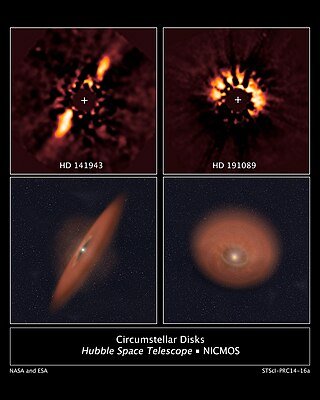Top Qs
Timeline
Chat
Perspective
HD 141943
Young Sun-like star with a circumstellar disk From Wikipedia, the free encyclopedia
Remove ads
HD 141943 is a young pre-main sequence G-type star with a circumstellar disk.[4] Due to the similarity between HD 141943 and the Sun (Sun-like), it resembles what the Sun would have looked like during the epoch of terrestrial planet formation in Solar System history.[5] Reconstruction of brightness maps of HD 141943 reveal a weak polar spot that changed little in latitude over the 4 year period in which it was observed. It also revealed significant amounts of low latitude features on HD 141943.[6]
It is a potential excellent candidate for telescopes such as the Hubble Space Telescope (HST), the Gemini Planet Imager (GPI) and the Very-Large Telescope (VLT) for follow-up observations of possible planet formation around HD 141943.[7]
Remove ads
Magnetic field

The coronal magnetic field of HD 141943 is dominated by a dipole which shows evidence of a possible tilt. The star also has a high differential rotation, about 8 times the value of the magnetic features of the Sun and 5 times the brightness features. This makes it similar to K-type stars.[10]
References
Wikiwand - on
Seamless Wikipedia browsing. On steroids.
Remove ads

